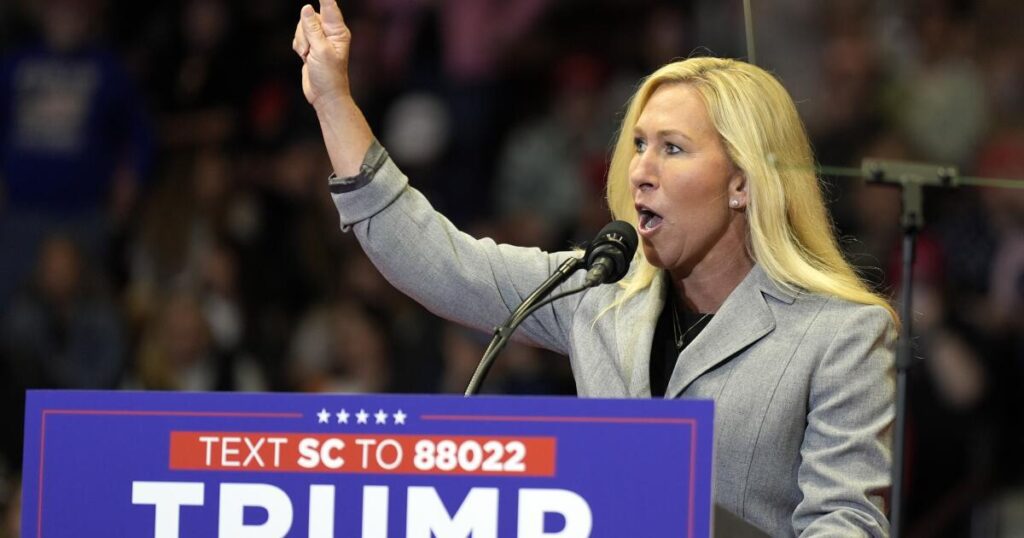The average U.S. House district includes about 590,000 voting-age people. How many of them do you expect to cast their vote for their representative in Congress? half? a fourth?
In 2020, the representative for Georgia's 14th Congressional District was effectively chosen by the 43,813 people who voted for the winner of the Republican primary — just 8% of eligible voters. In 2018, the representative for New York's 14th District was chosen by 16,898 people who voted for the winner of the Democratic primary, just 5% of eligible voters. In these two districts, one dark red and one dark blue, the dominant party's primary was the only election of significance.
Since their primary victories with such slim totals, Reps. Marjorie Taylor Greene (R-GA) and Alexandria Ocasio-Cortez (D-NY) have dramatically influenced their parties' priorities and direction, pushing them toward ideological extremes. Both MTG and AOC are beneficiaries of the prevailing party platform, which strongly favors candidates who can appeal to a trivial but passionate base in an unbalanced district.
Nonpartisan primaries, like the one California is holding on Tuesday, are a rare exception — one that could point the way to national political reform.
Greene and Ocasio-Cortez are not alone. Research by Unite America found that only 8% of voters nationwide cast ballots in the primaries that decided 83% of House contests.
how? First, 83% of congressional districts, such as AOC and MTG, are considered “safe” for one party or another. While some of this is related to gerrymandering, most districts are uncompetitive due to the growing partisan divide between urban areas (which lean Democratic) and rural areas (which lean Republican).
You might think we have a two-party system in America, but in most parts of the country, we actually have two one-party systems. In these places, primaries are the only elections with consequences.
Second, very few voters participate in primaries. That's because 22 states bar independents from voting in their primaries, according to a recent report by the United America Institute, disenfranchising 23.5 million registered independents. And this problem is getting worse: the percentage of voters not registered with any major political party has risen by about 20% since 2010.
Primaries not only determine the winners of most elections, but also give disproportionate power to small fringe factions. The result: More of our elected officials are less representative of America and less willing to work with the other side to solve problems.
Most of us take primaries for granted as an immutable feature of our politics that has always been with us. But they are not. California is now one of four states that avoid partisan competition for Congress.
The most powerful solution to the problems of partisan primaries is simply to abolish them. It is time for the next evolutionary phase in our electoral system to continue the tradition of periodic improvement since the nation's founding.
Eliminating partisan primaries supports two main principles: that all voters, regardless of party, should have the right to cast a ballot for any candidate in any taxpayer-funded election, and that all candidates must receive a majority of the vote to be elected. Reforming our primaries could give all voters an equal voice and require every candidate to meet the same standards. Most important, they can reward, rather than punish, politicians for doing what we elected them to do.
The most common means of eliminating partisan primaries to date is to replace them with nonpartisan primaries, often referred to as “at-large primaries” or “jungle primaries.” In a nonpartisan primary, all voters participate in a single primary in which all candidates are listed on the ballot with their self-selected party affiliation. The top finishers advance to the general election regardless of party and compete for majority support.
The path to primary reform does not require federal legislation or an amendment to the US Constitution, and it could have a transformative effect without occurring in all 50 states. In fact, I think the work of Congress would be greatly improved if six more states eliminated partisan primaries by 2026, bringing the total to 10. And voter-driven campaigns in many states, including Colorado, Nevada, Idaho, Montana and the South. Dakota could pass a nonpartisan primary through ballot initiatives this fall.
With two dozen senators and a few dozen representatives freed from the political margins and able to form new coalitions to actually govern, I believe we will have the critical mass to begin tackling the major challenges that seem insoluble today.
A democracy controlled by extremists at the expense of the majority, and offering division rather than solutions, cannot continue indefinitely. The self-reinforcing cycle of hyperpartisanship will not end on its own. We should judge proposals to change course not against perfection but against the status quo.
Eliminating party primaries is not a magic solution. But California and others have shown that it is a feasible and effective way to begin reversing our toxic polarization.
Nick Troiano is the author of The Fundamental Solution: Saving Our Democracy from the Margins, from which this book is adapted, and is the CEO of Unite America, a philanthropic investment fund that invests in nonpartisan election reform.
